All posts by Jim Woodmencey
String Lake

Jackson Peak on Easter

Jackson’s Cold and Snowy Winter of 2022-23
One year ago, we were lamenting about a sub-par winter season. We had a big December for snowfall in 2021, then a lackluster January through March in 2022. Only to get dumped on by one of the snowiest April’s on record.
This year the story was a little different, snow started falling in late October and hardly let up for the next five months. Temperatures were also much colder than normal from November all the way through March, allowing the snow to accumulate to great depths, around the valley and in the mountains.
Colder and much snowier than normal was the scene across many areas of the Western United States this winter. Here I will highlight just how cold and snowy it was here in Jackson Hole, Wyoming
Cold Town Temps
It all began back in November, when Jackson had its coldest November ever recorded, with a mean temperature for the month of 17 degrees. That was 11 degrees colder than the long-term average temperature in November and it beat the old record from 1938 by nearly two degrees.
The cold temps never let up. December 2022’s mean monthly temperature was three degrees colder than the long-term average, January 2023 was two degrees colder than average, February 2023 was eight degrees colder, and March of 2023 ended up a full nine degrees colder than the long-term average temperature for March in Jackson.
From November 1st, 2022, through March 31st. 2023 the Town of Jackson recorded 65 days with minimum temperatures of zero degrees or colder. That’s 43-percent of the days over the past 5 months that we woke up to temps at or below zero.
The coldest day of the winter was on January 31st, 2023, when the official thermometer at the Jackson Climate Station registered 33 degrees below zero. The last time it was colder than that in town was on December 23rd, 1990, when it got down to 40 below zero.
That all adds up to a ridiculously cold winter and should toss any notions about global warming out the window, at least on a local scale. The much colder than normal temperatures of the past five months only added to the trend in Jackson of colder than average annual mean temperatures that we have seen over the last 10 years now.
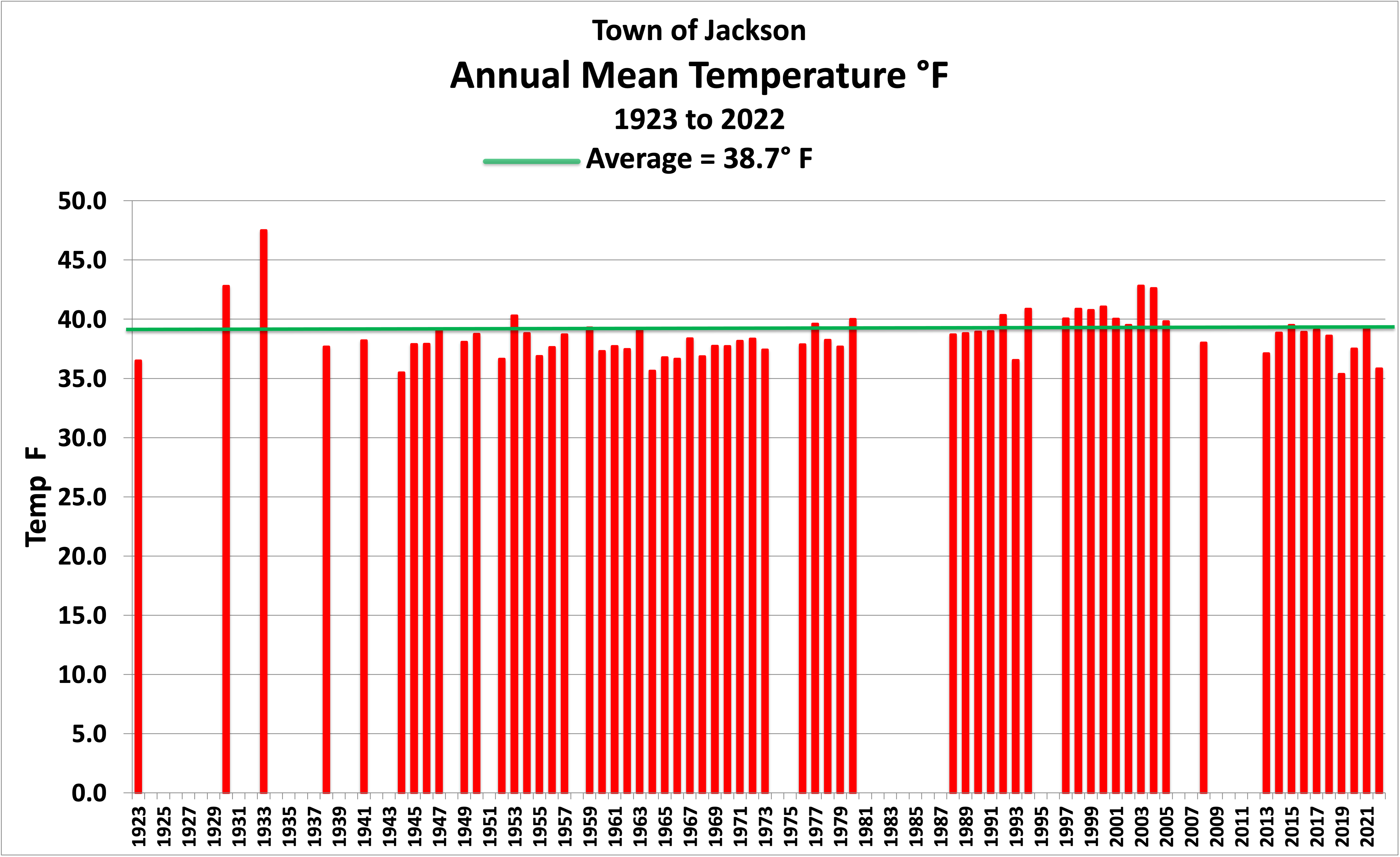
Big Town Snow
Total snowfall recorded at the Jackson Climate Station from December 1st, 2022, through March 31st, 2023, was 83 inches, compared to the average snowfall for that four-month period of 61 inches.
Last year the October through March snowfall total in town was only 56 inches. However, you may recall that April 2022 roared in with an additional 17 inches of snowfall in town, when traditionally April only averages around 4 inches of snow. April of 2022 tied for the third snowiest April on record in town.
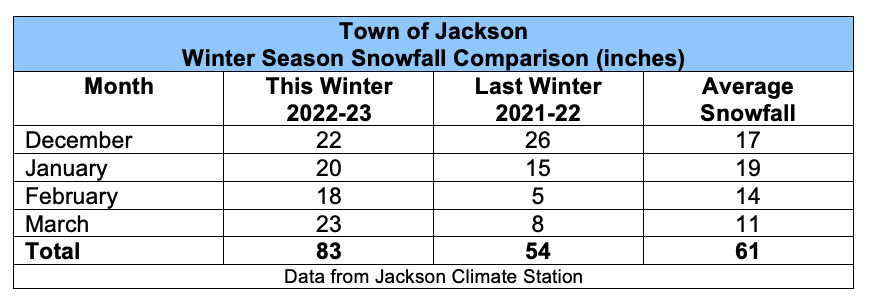
If you add the snowfall from October and November of 2022 to the total, of one inch and 21 inches, respectively, then the total snowfall from October 2022 through March 2023 comes to 105 inches. That means, if you live in town, you had to shovel, blow, or plow almost nine feet of snow out of your driveway this winter.
That entire fall and winter season snowfall total of 105 inches is 148-percent of the town’s long-term average snowfall for October through March of 71 inches.
More info about the trends of colder and snowier in Jackson can be found in my blog post: Review of the Weather in 2022
Record Town Depths
Because of the colder than normal temperatures all winter long, snow on the ground barely had any opportunity to melt and settlement of the snow pack in the valley was minimal. During the first week in April the settled snow depth in town at the climate station was at 26 inches on April 3rd. That is the deepest snow ever recorded on that date in town, breaking the record on that date of 22 inches from 1985.
On April 5th, 2023 the settled snow depth was 24 inches, breaking the old record of 18 inches from 2008. April 6th also established a new snow depth record in town. The average snow depth during the first week in April in the Town of Jackson is between 4 and 5 inches. So, if you thought there was a lot of snow on the ground for this time of year, your observation was correct.
Record Mountain Snow
At Jackson Hole Mountain Resort’s Rendezvous Bowl weather station, at around the 9,600-foot elevation, the total snowfall for what I will call the ski-season, from December 1st, 2022, to April 1st, 2023, was 443 inches. That is 143-percent of the average snowfall for that four-month period at Rendezvous Bowl, which is 309 inches.
Total snowfall during last year’s ski season was 241 inches. December 2021 alone accounted for 112 of those inches and was the only month of last winter’s ski season that had above average snowfall. April of 2022 added another 79 inches of snowfall, but most of that fell after the ski area had closed.
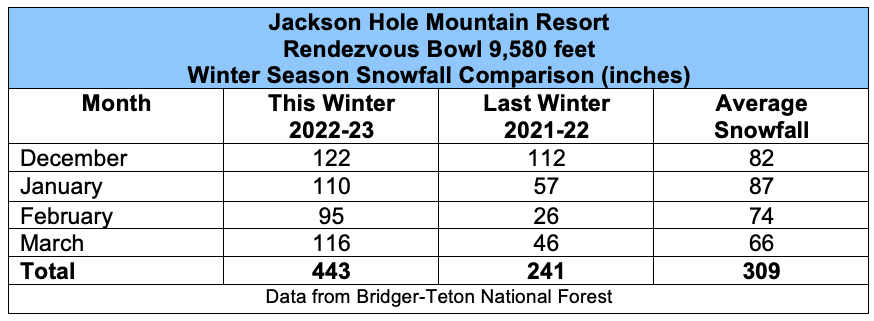
In the bigger picture, the total snowfall recorded on the mountain from October 1st, 2022, to April 1st, 2023, was 572 inches. That was only four inches shy of the record snowfall from the winter of 1996-97, which had 576 inches of snowfall during that same period. That would make the winter of 2022-23 the second snowiest ever recorded on the mountain, for total snowfall between October 1st and April 1st.
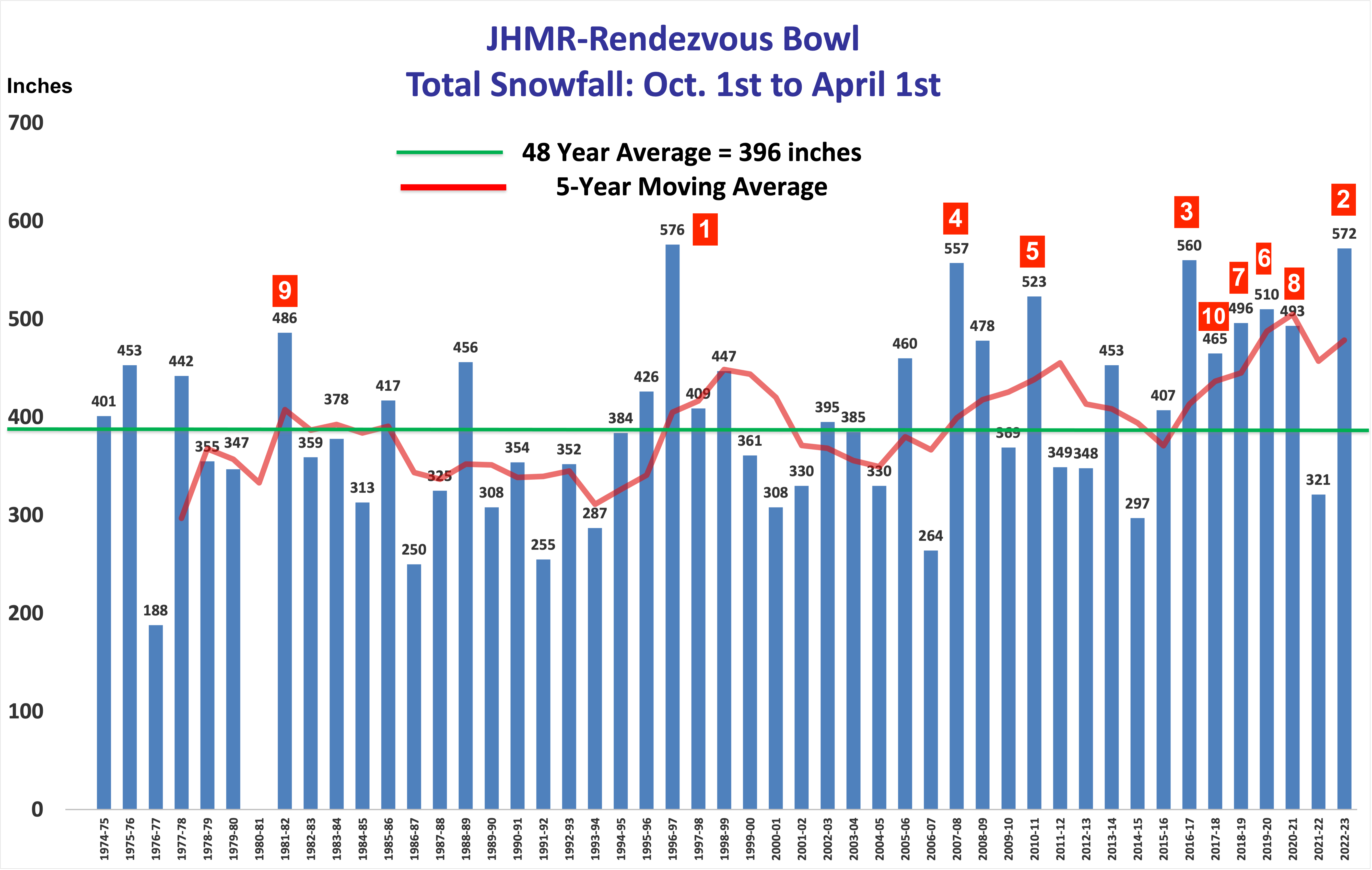
However, if you include snowfall data through closing day, then the winter of 2022-23 surpassed was the snowiest winter ever recorded on the mountain, with a grand total of 595 inches of snowfall this season. That beats the 585 inches that fell during this same time period in 1996-97 and also the 590 inches that was recorded in the winter of 2017-18 from October 1st through April 9th.
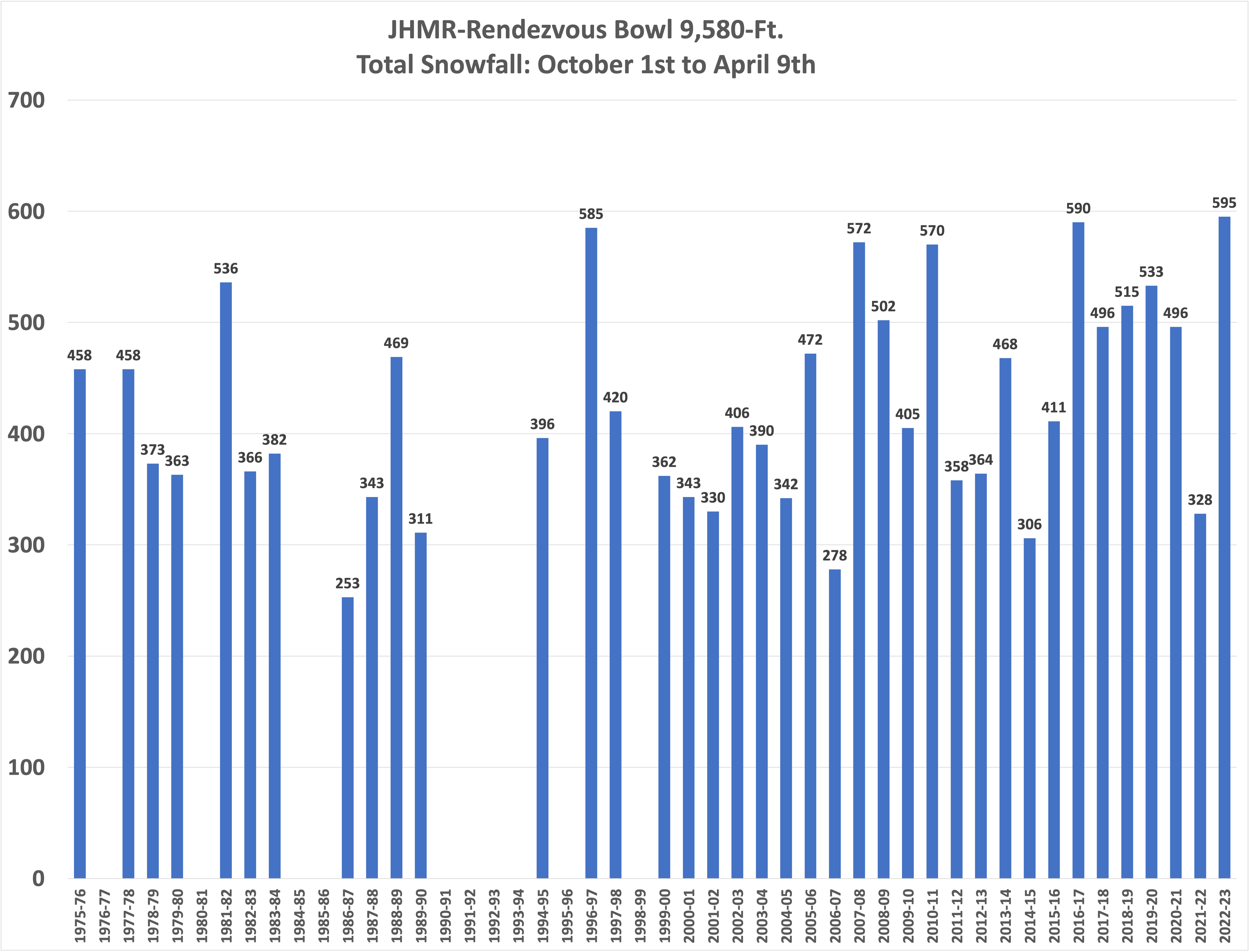
Bottom-line is, no matter how you slice it, 8 out of the top 10 snowiest winters at the Jackson Hole Mountain Resort occurred in the last 15 years. Five of those top-ten winters happened within the last six years! The winter of 2021-22 was the only year in the last six that saw below average snowfall.
Mountain Snow Depths
Once again, colder temperatures made for lower density snowfall throughout this past winter. That made for great powder skiing and provided some of the best coverage, top to bottom on the mountain, than we have seen in years, since 2010-11 at least.
When the season ended on April 9th this year, the settled snow depth in Rendezvous Bowl was at 129 inches. Last year on April 9th, 2022, it was only 73 inches deep. Ten feet vs. 6 feet of snow depth at 9600-ft. The average depth on April 9th is 106 inches. The deepest ever on that date was in 2017, with 159 inches.
What made the skiing even better was the fact that snow depths at the base of the mountain stayed deep all winter also. I skied on closing day and did not see a single rock or bare patch of ground exposed on any of the major runs. That is not the usual case in early April.
Snow depths at the base of the mountain on April 9th, 2023 stood at 37 inches. Last winter, on April 9th, 2022, the snow depth was 9 inches. The deepest ever was in 2011, with 40 inches. The average snow depth on that date at the base is 21 inches.
A Unique Winter
What made this winter so exceptional was the fact that it was consistently colder and snowier than normal for five consecutive months, which made for very consistent skiing conditions all season long. So, if you like snow, this was truly a dream winter in every meteorological sense.
And to all those climatologists who have been making the same claim now for the past 20 years that, “within a few years, we aren’t going to know what snow is”, I would say, come spend a winter in Jackson Hole.
Jim is the chief meteorologist at mountainweather.com and has been forecasting the weather in Jackson Hole and the Teton Range for over 30 years.
Bison and Tetons

Plume on the Grand

Jackson Trends Colder, Wetter & Snowier than Normal
The bottom-line for the year 2022 in Jackson, Wyoming was, it ended up much colder, much wetter and much snowier than normal. As a matter of fact, the overall trend for the last seven years now has been leaning in those directions.
Below is a full review of all the weather statistics from the Town of Jackson’s Climate Station, showing how 2022 compares to recent years and to the long-term averages. I’ll begin by looking at the temperatures and wrap it up by looking at precipitation and snowfall numbers. You can also refer to the summary table at the end of this post.
Colder Temperatures in 2022
Nine out of twelve months in 2022 had colder than normal temperatures, including the coldest November ever recorded in town and the 7th coldest April on record. March and September were the only two months in 2022 that had warmer than normal temperatures. July ended up right at average, temperature-wise.
The average high temperature for the entire year was 50.5 degrees Fahrenheit. That is more than three degrees colder than the long-term historic average annual high temperature of 53.8 degrees. Officially, the hottest day of the year in 2022 at the Jackson Climate Station was 89 degrees on July 17th.
The average low temperature for the year was 21.2 degrees, or almost three degrees cooler than the long-term historic average annual low temperature of 22.9 degrees. The coldest days of the year in 2022 were on December 22nd and 23rd when it reached 25 below zero on the official town thermometer.
The annual mean temperature for 2022, the average of the annual high and low temperatures, checked in at 35.8 degrees. Jackson’s long-term average annual mean temperature is 38.3 degrees. That is 3.5 degrees colder than normal, making 2022 the fourth coldest year on record for the Town of Jackson.
(See graph of annual Mean Temps below).
You may recall it was only three years ago that Jackson had its coldest year ever recorded, in 2019. The annual mean temperature that year was 35.4 degrees, beating the old record from 1944 of 35.5 degrees, by one-tenth of a degree. Besides 2019 and 1944, the only other year colder than this past year was in 1964, with an annual mean temperature of 35.6 degrees.

Precipitation Above Normal
Jackson received a grand total of 18.99 inches of precipitation in 2022. That is more than three inches above the historic average. Amazingly, that number was reached with six months of the year receiving below normal precipitation, and the other six months receiving above normal precipitation.
Precipitation came in an alternating pattern of dry and wet. January, February, and March were all drier than normal. April and May were wetter. June was near average, and July was bone-dry. August was very wet, ending up as the wettest month of the year in 2022, with 3.65 inches for the month. September was wetter than normal. October was also very dry, then November and December 2022 were both much wetter than average.
In the last seven years, there has only been one year that the Town of Jackson has had precipitation that was below the long-term average. That was in 2020, when the precipitation total was 15.26 inches, a little more than a half-inch below average. Historically, the average annual precipitation in town, from years with complete data between 1905 and 2016, is 15.83 inches.
Snowfall Above Normal
Snowfall to start the year 2022 was nothing to write home about. January, February, and March only recorded a total of about 30 inches of snowfall in the Town of Jackson. The average snowfall for those three months in town is closer to 45 inches. Then came April, with just over 17 inches of snowfall, when normally Jackson averages only 4 inches for the month.
April of 2022 became the third snowiest April in town, behind the 18 inches in April of 1963, and the 24 inches in April of 1967.
Skipping ahead to the end of the year, both November and December of 2022 were above normal for snowfall in town. November added just over 20 inches of snow and December another 22 inches to the annual total.
The final tally of annual snowfall in the Town of Jackson, January through December 2022, was 92 inches. That’s about 20 percent more than the long-term average for annual snowfall in town of 77 inches.
For those who think it just doesn’t snow like it used to, look at the table. Six out of the last seven years have ended up with above average snowfall in town. Last year, 2021 was the only year that wasn’t, and even that year checked in right at the long-term average of 77 inches.
The last year that had below average snowfall in town was in 2015, with 58 inches. But in 2014, Jackson had 101 inches of snowfall.

Summary
These most recent seven years that are listed in the table are starting to show a trend, when compared to Jackson’s long-term historic averages. That trend has been towards colder – especially regarding high temperatures – towards wetter, and towards snowier weather in Jackson. I would think that is all good news and should dispel any myths about becoming warmer, drier, and less snowy.
Jim is the chief meteorologist at mountainweather.com and has forecast the weather in Jackson Hole for over 30 years.
Blue Sky Day

December 2022 Temperature Roller Coaster
Temperatures during the last month of 2022 took quite a roller coaster ride in the Town of Jackson, WY. More than once during the month we experienced temperature swings, both up and down, of over 50 degrees Fahrenheit.
Depending on the upper level flow direction at the time, which determined if temps were going up or going down, some of those changes occurred in a very short period of time.
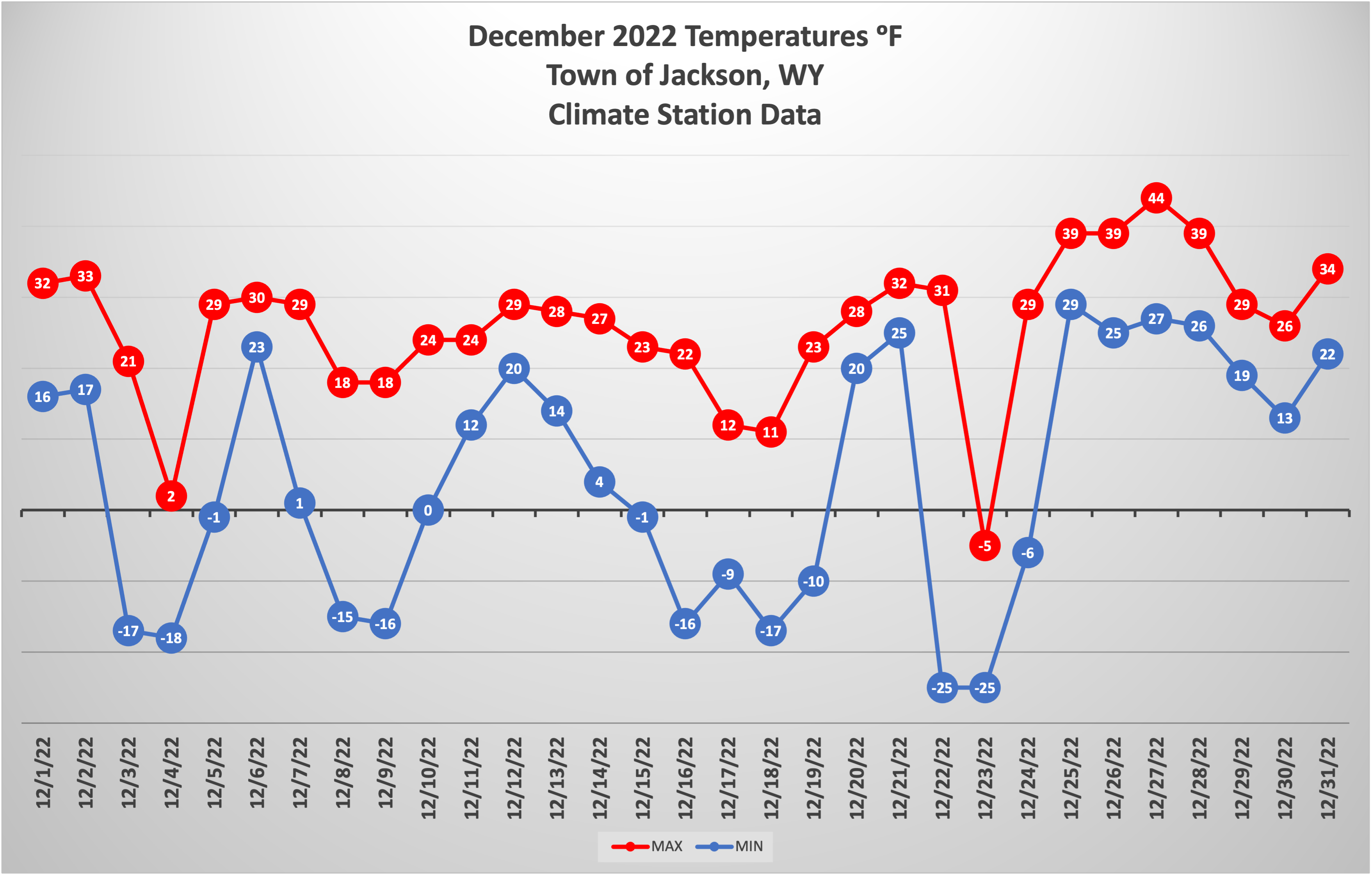
The swinging pendulum began at the beginning of the month with a 50 degree change in temperature from a high of 33 degrees on the afternoon of December 1st (temps are recorded each morning at 9:00 am local time for the previous 24-hours). The low temp on December 3rd was minus 17 degrees. A 50 degree drop in just 2 days.
Two days after that, on December 5th, the high was back up to 30 degrees above zero, a 48 degree rise in temperature. Followed by a drop back down to 15 below zero on December 8th, a 45 degree change in the other direction.
The biggest plummet of temperatures though occurred on the Winter Solstice, December 21st to 22nd, 2022. That was followed just a few days later by a significant resurrection of temperatures. Here is how that story unfolded.
Cold Solstice
The Winter Solstice arrived with some gusto this year in Jackson Hole, with near blizzard conditions, followed immediately by a blast of Arctic air from the north that had temperatures dropping to 25 degrees below zero Fahrenheit.
The official high temperature at the Jackson Climate Station on December 21st, 2022 actually occurred in the morning, when it reached 31 degrees before 9:00 a.m. The low temperature the following morning, December 22nd, was 25 degrees below zero, a 56 degree drop in 24 hours.
Warm Christmas Weekend
It was also 25 below zero on December 23rd. Three days later, on the afternoon of December 26th, a southerly flow of air brought the high temperature all the way up to 44 degrees in the Town of Jackson. That’s a 69 degree rise in temperature in three days time.
Talk about a hard place to dress for!
Similar to 2016
Yes, those were unusual temperature swings. But we saw a similar roller coaster of temperatures in December of 2016. There were 50 and 60 degree temperature swings in Jackson that December, as well.
Here is what that month looked like:
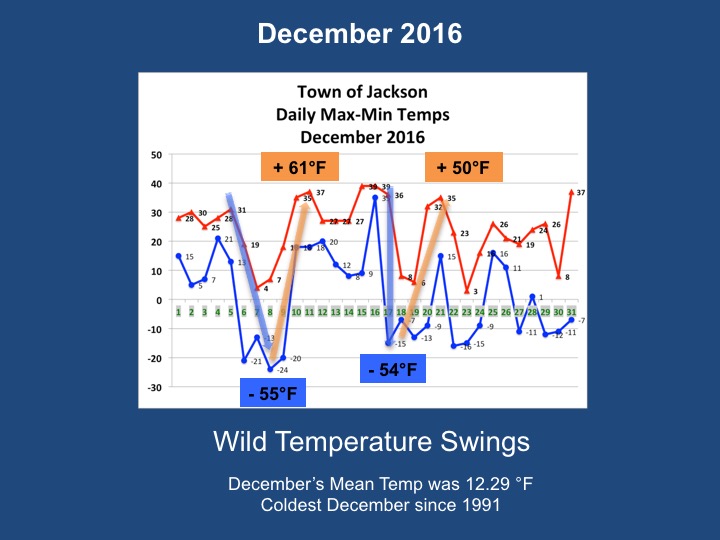
Record Cold in Casper, Wyoming
Perhaps the most impressive temperature drop I could find in Wyoming over the Winter Solstice this year was in Casper, WY. On the morning of December 21st, 2022, Casper’s airport thermometer went from 28 degrees above zero at 7:40 a.m. to 6 degrees below zero at 8:40 a.m. when the Arctic air arrived. That’s a temperature drop of 34 degrees in one hour.
Twenty-four hours later, on the morning of December 22nd, the low temperature in Casper was 42 degrees below zero. A precipitous cold plunge of 70 degrees from the previous morning’s reading of 28 degrees above zero.
That minus 42 degree reading broke Casper’s all-time cold temperature record. Prior to this December, the coldest temperature ever recorded in Casper was minus 41 degrees, on December 21st, 1990.
Posted by: meteorologist Jim Woodmencey
Mid-Layer Fog Tetons


